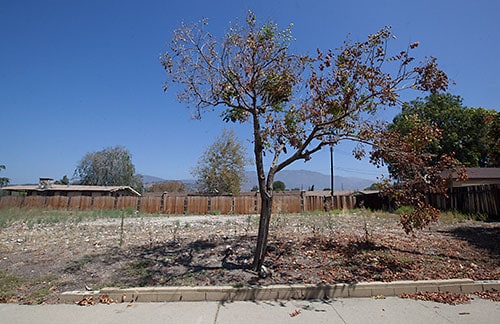Drought takes its toll on health of Claremont’s trees

The verdant canopy of pines, oaks and elms, a source of pride for Claremont homeowners, sets the city apart from its neighbors. The drought and escalating water prices, however, have locals questioning our once steadfast nickname—the City of Trees.
The area’s urban forest has been at the forefront of local discussion of late, as residents band together to protect Claremont’s lush landscape. Advocates like the recently-formed Tree Action Group have played a key role in ensuring a more defined plan is put in place for the city’s leaf-scape. This has proved instrumental as the city’s community and human services department works to amend its longstanding tree policy. The updated tree manual, currently in the review process, is expected to come before the Claremont City Council this spring.
Adding to the recent tree talk is the city council’s decision to make the maintenance of the urban forest a top area of interest for 2014. And rightly so, residents say. With the worst drought the state has seen in decades, many insist action must be taken to ensure future damage is not done. Lack of water might not appear to harm a tree in the short term, but over the long haul it can be disastrous, notes John Garbo, owner of Johnny’s Tree Service.
“Lack of water causes the trees to be stressed, and when a tree is stressed, its immune system is compromised,” Mr. Garbo said. “Trees have a normal immune system that keeps bugs out and parasites off. When a tree is under stress, that’s the first thing it gives up.”
Kathleen Trepa, director of community and human services, says the city has taken steps to ensure public trees are protected, particularly those of historical note. Trees located on city property—such as in parks, medians and at public facilities—are being watered through irrigation systems, Ms. Trepa relates.
“Those systems are set/adjusted based on watering needs, taking into account weather conditions, so most of the trees we are responsible for watering are on irrigation systems,” she said. “This winter, we have also issued advisories in the City Manager’s Weekly Update and the City Newsletter, which is distributed community-wide, about the need to deep-water trees, even during the winter months, given the lack of normal rainfall.”
Claremont officials are going a step further to help residents with their watering needs during the drought. In updating the city’s tree policies, Ms. Trepa says the city is evaluating the option of issuing watering bags—allowing slow, deep watering— to property owners who have newly planted a tree. While the city has yet to purchase these watering bags, the devices are available both online and in local stores in the meantime.
Mr. Garbo recommends adopting drip water irrigation, like water bags, and steering away from spray water irrigation, like sprinklers, which he advises are both wasteful and less helpful.
“You want the water concentrated in that area. Then it percolates down and doesn’t run off,” he explained.
Further, Mr. Garbo recommends adding a thin layer of tree mulch, not at the trunk but at the drip line, to protect the trees roots and prevent water loss. However, he cautions, be careful not to over mulch or it becomes repellent to water.
While older trees are more immune to the dry weather, thanks to their established root systems, homeowners should take particular care of younger trees still taking root. Residents looking to save on watering costs should also be wary of resorting to ripping out their lawns too quickly. While drought-tolerant landscape is encouraged, April Garbat, a certified arborist and communication specialist with Rancho Santa Ana Botanic Garden, recommends a slow switchover to wean the yard’s treescape.
“Be careful about suddenly taking all of that water away. It can take several years to taper a tree off if it’s used to being in your yard,” Ms. Garbat said. “It would be like us going on a starvation diet and trying to live off juice for a year. You can’t do that healthily.”
But there’s no need to panic. While fruit trees will need to be watered more frequently during the drought, Ms. Garbat assures most of the local trees are fairly drought resistant—like the cedars, sycamores, oaks and elms. For watering at her home, Ms. Garbat uses a hose set on low with a timer, since she admits remembering to turn off the hose can get lost in the daily shuffle. Golden State Water offers a rebate on these devices for those considering the option themselves.
For detailed information on how to take care of specific tree varieties, she recommends visiting www.waterwise.com or www.californianativeplants. com. Although the drought might mean more careful maintenance, Ms. Garbat hopes it won’t hold residents back from flexing their green thumb.
“Starting new plants during the drought can be challenging in the beginning, but the long term benefits are definitely there,” she said.
—Beth Hartnett
news@claremont-courier.com









0 Comments